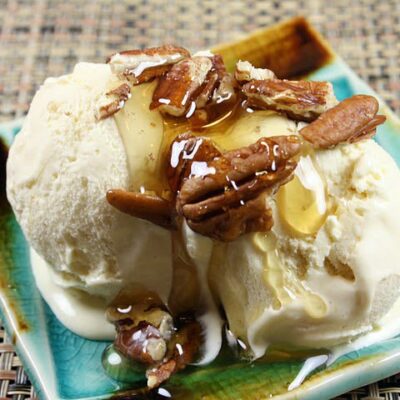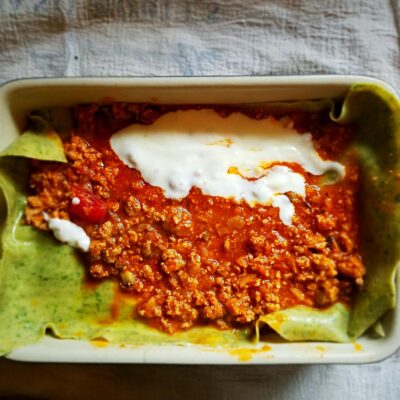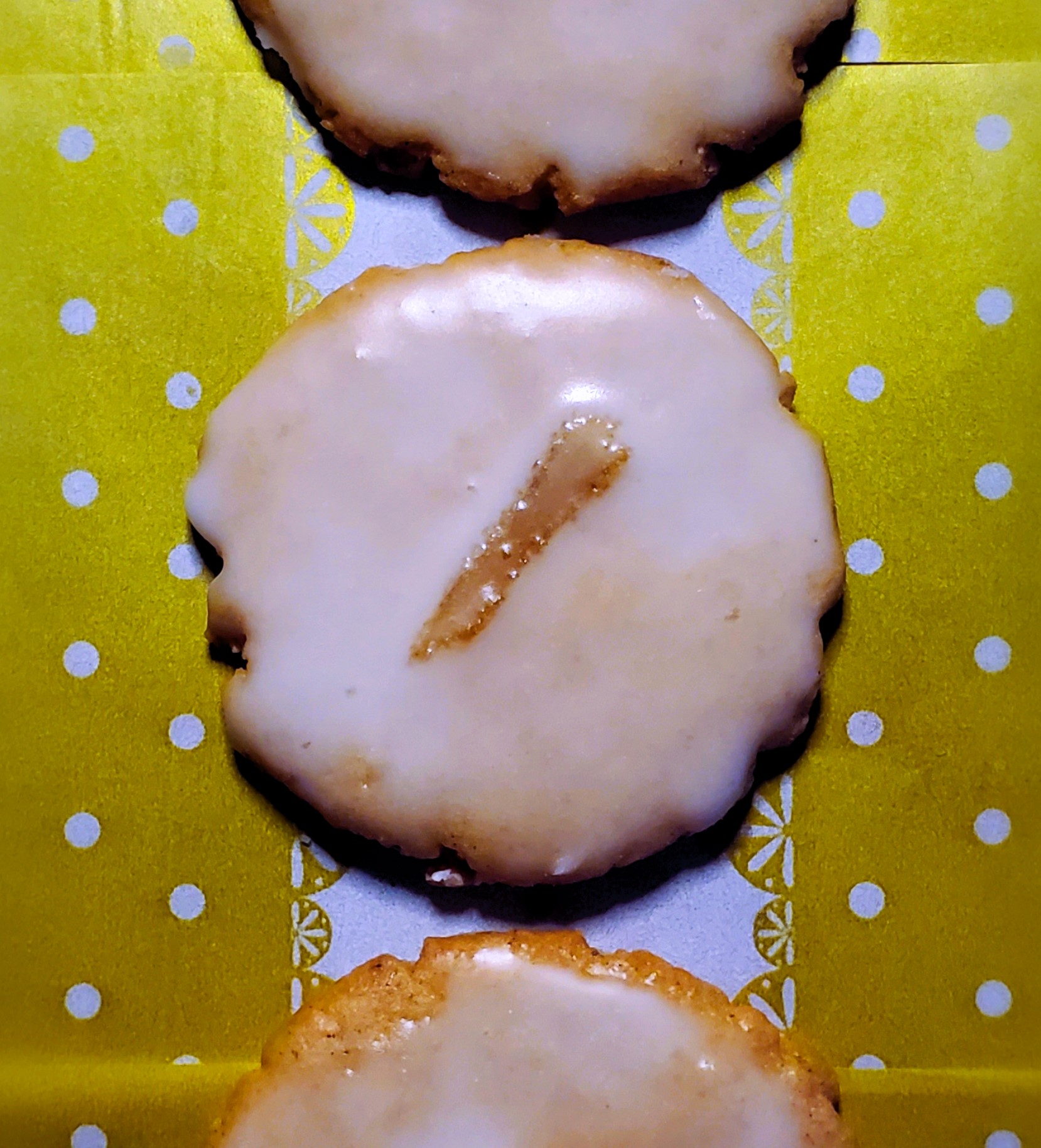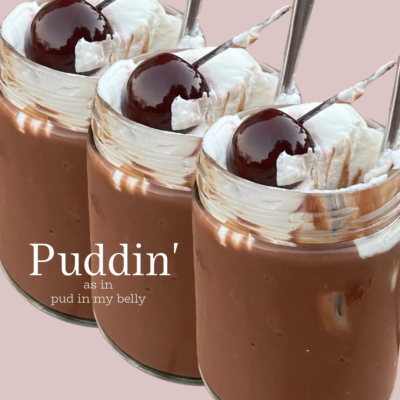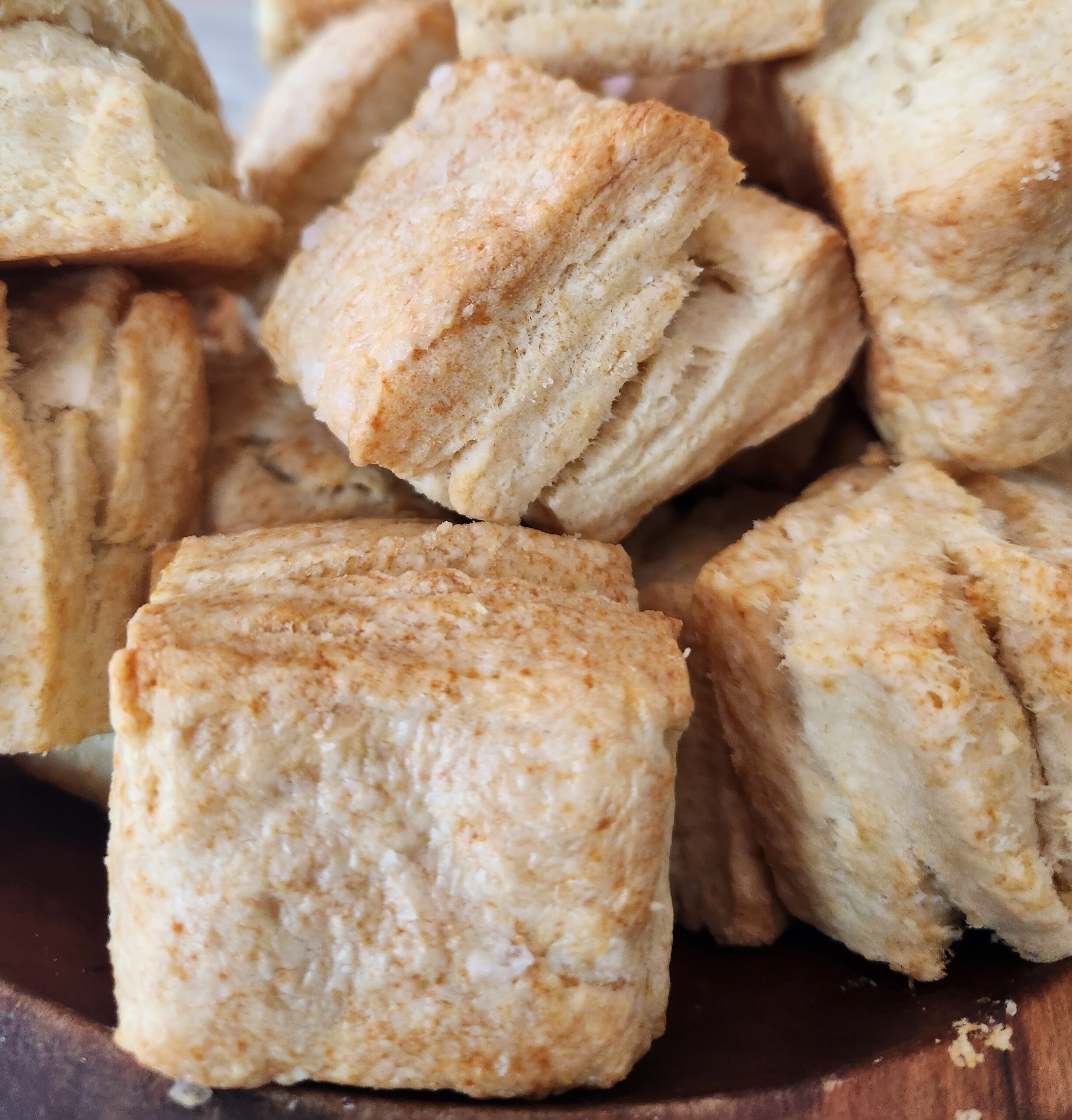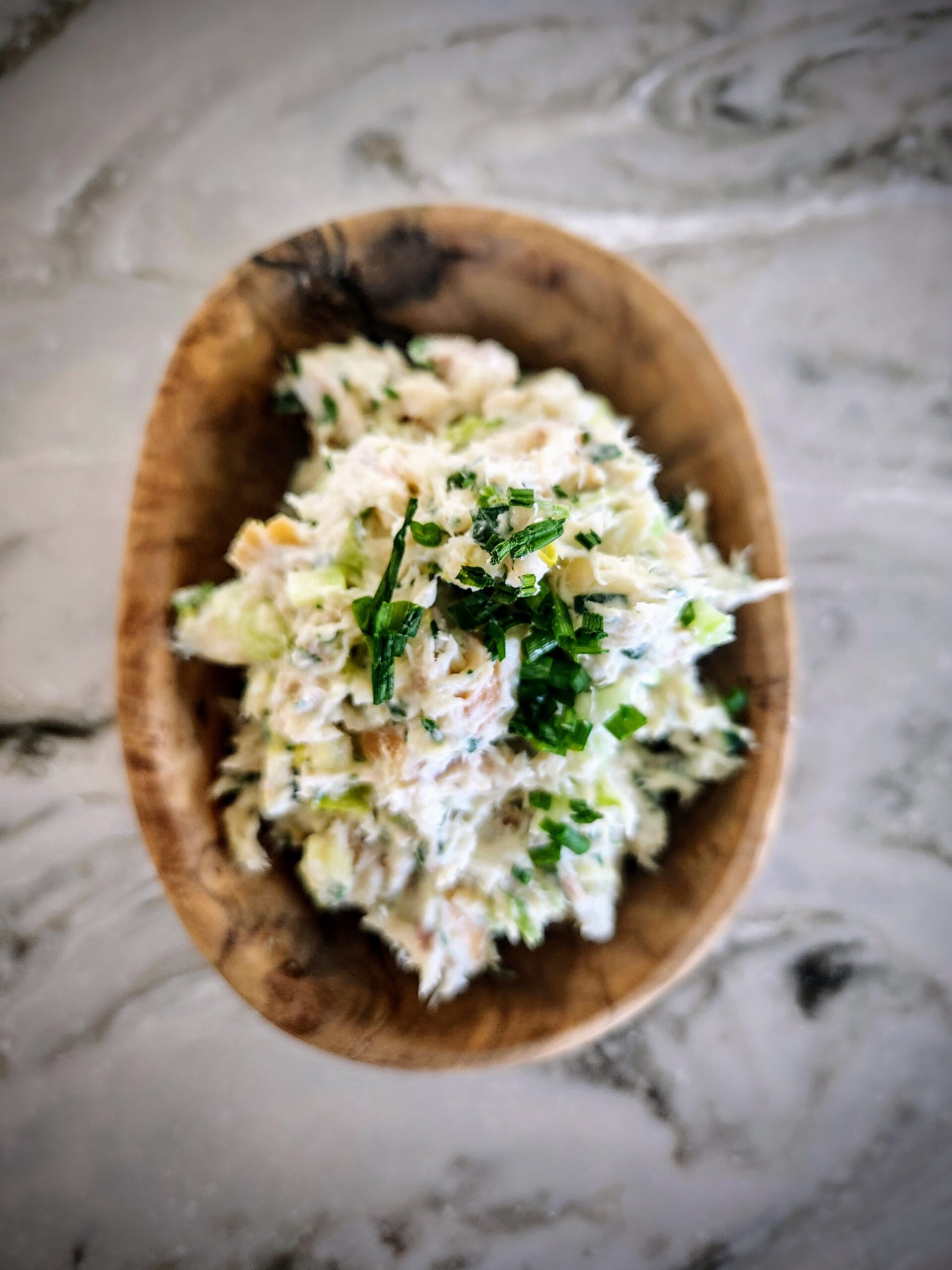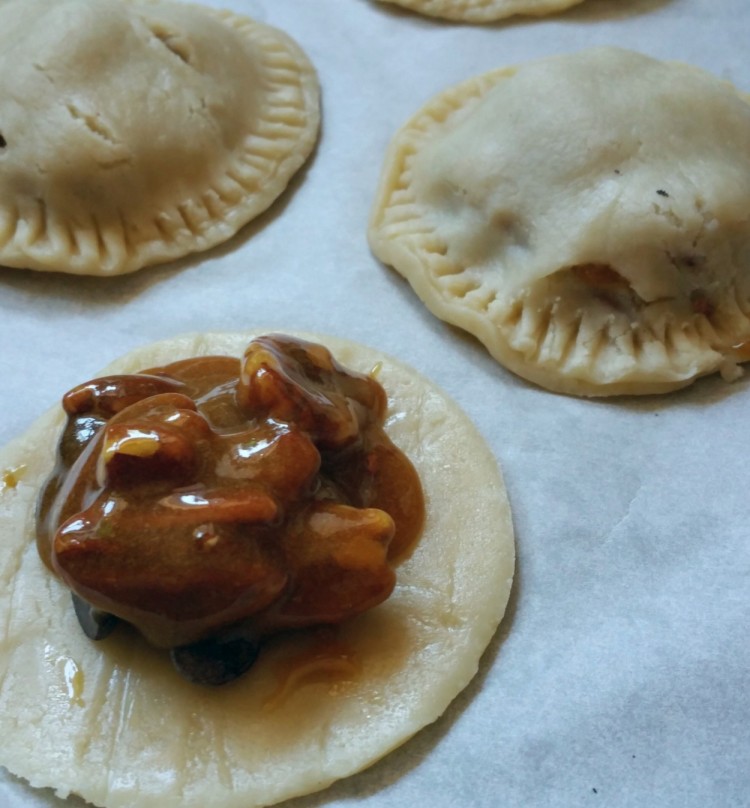
Bourbon Pecan Hand Pies
On May 1, 2015 by sixtyacrebakerThe season is starting. The season where you would rather be standing at the first turn cheering your horse, than sitting inside, fork in hand. This weekend is a race and event, anticipated like Christmas and filled with tradition. Every Southerner I know has a menu they serve every year, and their favorite milliner on speed dial. In breaking with tradition, this year, I am servingg hand held derby-like pies. In your left hand a buttery crust, filled with bittersweet chocolate, pecans and bourbon custard, in your right hand a winning ticket. Add a ice cold mint julip for your very own trifecta.
Bourbon Pecan Hand Pies
makes about 10-4″ hand pies
1 recipe pie crust
filling
1/3 cup honey
1/3 cup brown sugar
generous pinch kosher salt
3 Tbs bourbon
3 large egg yolks
2 Tbs unsalted butter
1 cup pecans-toasted
about 3/4 cup bittersweet chocolate chips
Use your favorite pie crust recipe, or purchase already prepared.
Place honey, brown sugar, kosher salt, bourbon and egg yolks in a saucepan. Whisk until well incorporated. Place over low heat and stir continually with a rubber spatula until mixture thickens. Coat the spatula with the mixture and run your finger down the middle of it. If doesn’t run back together, then it is ready. Run through a strainer into a clean bowl. Add butter and stir until incorporated. Stir in pecans. Refrigerate until ready to use.
Roll out your pie crust to about 1/4″ thick. Using a round cookie cutter, cut out an even number of circles. Line a sheet pan with parchment. Place 1/2 of your rounds on the parchment, approximately 1/2″ apart.Place a tablespoon of chocolate chips in the center of the circle. Top with a generous spoonful of filling. Place a second round of crust on top. Brush with egg yolk and bake in 400F oven for about 15 minutes or until golden brown.
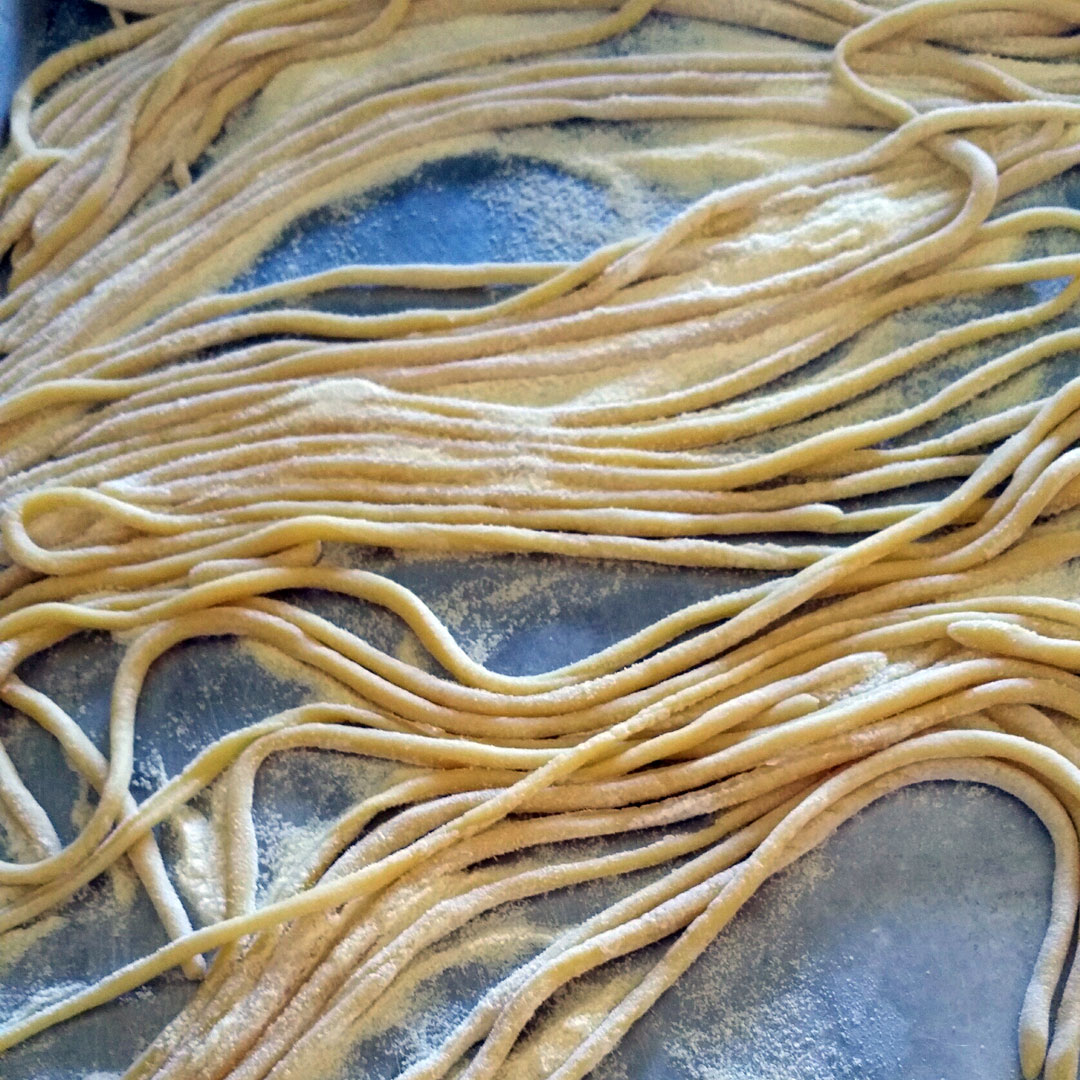
Pici Pasta
On April 26, 2015 by sixtyacrebakerPici pasta is a favorite of mine. When I see it on a menu, I order it. Pici is in a class of its own. It is fresh and chewy, and incredibly slurpable. Truth be told, I use this dough for my cavatelli as well, because of the chew factor.
When I was a kid, my grandparents would arrive on the day summer vacation began and stay until labor day. Some kids would come back from summer vacation, tanned, thin and 3 inches taller than they were when they left? Not this kid. My belly would be slightly rounder, I’d rattle off Italian phrases like I was Sophia Loren. I knew who Sophia Loren was. I was tan. We’d spend long evenings on the sun porch, eating, laughing, listening to the radio, and playing cards. My grandfather was an ace gin player and at a penny a point, we barely noticed our piggy bank dwindling. The food we ate was always delicious, and always from scratch.
Upon the gran’s arrival, the suitcases were hauled into the kitchen and unloaded. It was like Christmas. Literally. Grandma Grace would bring the Christmas stockings she collected from her bank and held from December until June. They were filled with hard candy and cheap toys; we loved them…and her for carrying on this tradition far longer than we really deserved. The grandmas were a tag team. Although they only saw each other this one time a year, they collaborated all year on what to bring with them to California. Out of the cases would come whole salami and prosciutto, buckets of polly-o and parmesan, capers, olives, anchovies. They were like traveling deli salesmen.
We didn’t think it odd at all.
Around day two or three the pasta making began in earnest. The dining room table, the pool table, the kitchen table, were all covered in sheets and dusted with flour. The pasta roller was brought down from the high shelf in the service porch and everyone was enlisted in the task of making pasta. We had one shot at making enough pasta for the summer. Mapping out how many dinners, who would be visiting, how much would each person eat, and what type and shape of pasta was a bit of an ordeal. The kitchen a bustle, until pasta making began. The room became silent. Everyone with a task; everyone working toward a common goal.
My job was always to transfer the pasta from the kitchen to its assigned table. Sometimes, most times, more went into my mouth than on the table. yes raw. Especially if it was cavatelli. I just loved the chew.
Still do.
Which is why I love this recipe. It has that bit of a chew. It also has a raw egg, so eating it uncooked is a risk you have to decide about on your own.
Semolina Pasta Recipe
*use for pici, cavatelli, orecchiette
2 cups 00 flour
1 cup semolina flour
3/4 tsp kosher salt
1 extra large or jumbo egg (i use a duck egg)
1 Tbs olive oil
1/2 cup (+/-) cool water
Place 00 flour, semolina flour and salt in a large bowl. Mix to combine. Make a large well in the center of the flour and fill with egg, olive oil, and 1/2 cup water. Using a fork mix together until all flour is moistened and the mixture is coming together. Use your hands to get the dough together in a ball. Turn out onto a floured work surface and knead for approximately 10 minutes. The dough should not be wet, and it shouldn’t be scraggy, but it should be a bit stiff. If the dough is too wet, use a bit of flour when you knead…just a bit at a time.
Wrap in plastic wrap and place in the refrigerator for about 1 hour.
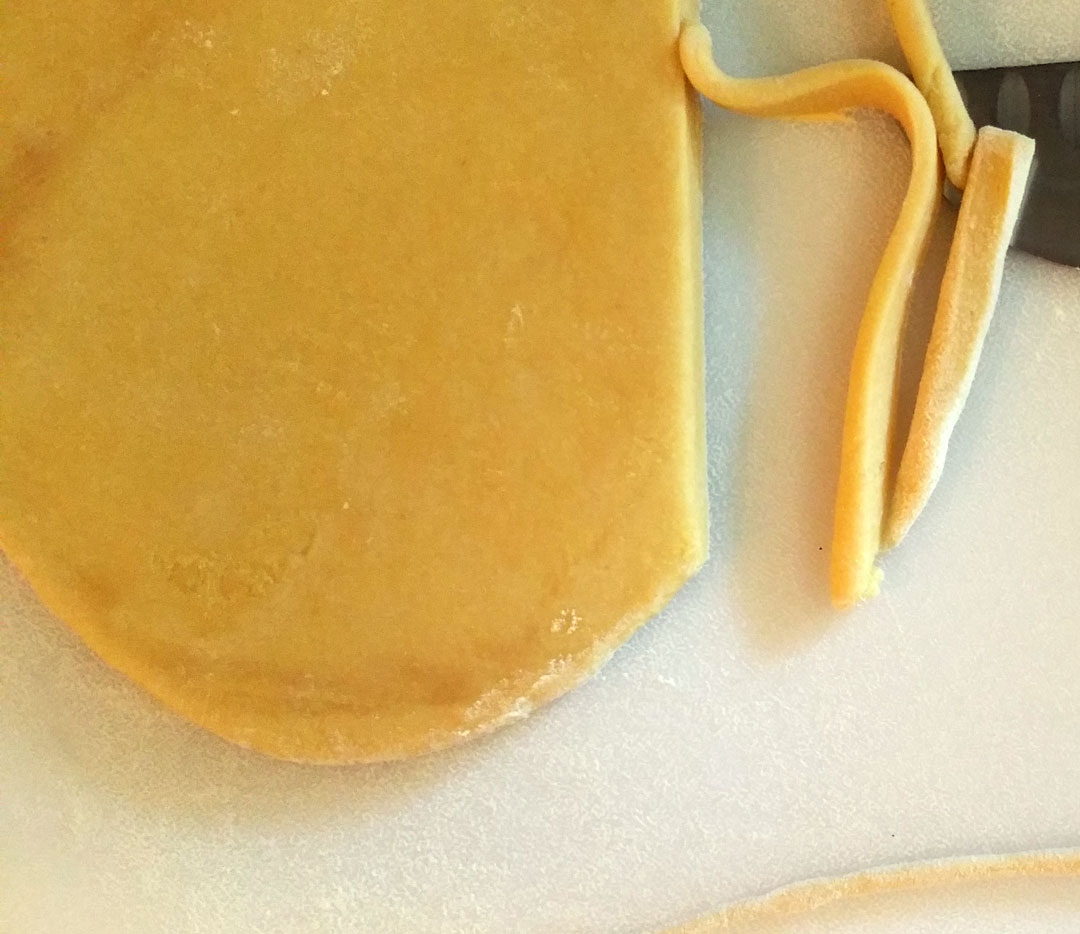
To roll out the pici:
Roll the dough with a rolling pin, on a lightly floured surface to about 1/4″ thick. Using a knife, cut the dough into strips about 1/8″ wide. Gently roll each piece on a lightly floured surface, starting from the center, and work your way out. Place on a tray dusted with semolina flour.
Cook in a large pot of salted boiling water for about 8-10 minutes. Serve with your favorite ragu.
** pici pasta is not spaghetti. it is thicker and a bit denser. As I said before, it has a bit of a chew to it.
Here is a short video demonstrating how to roll out your pici
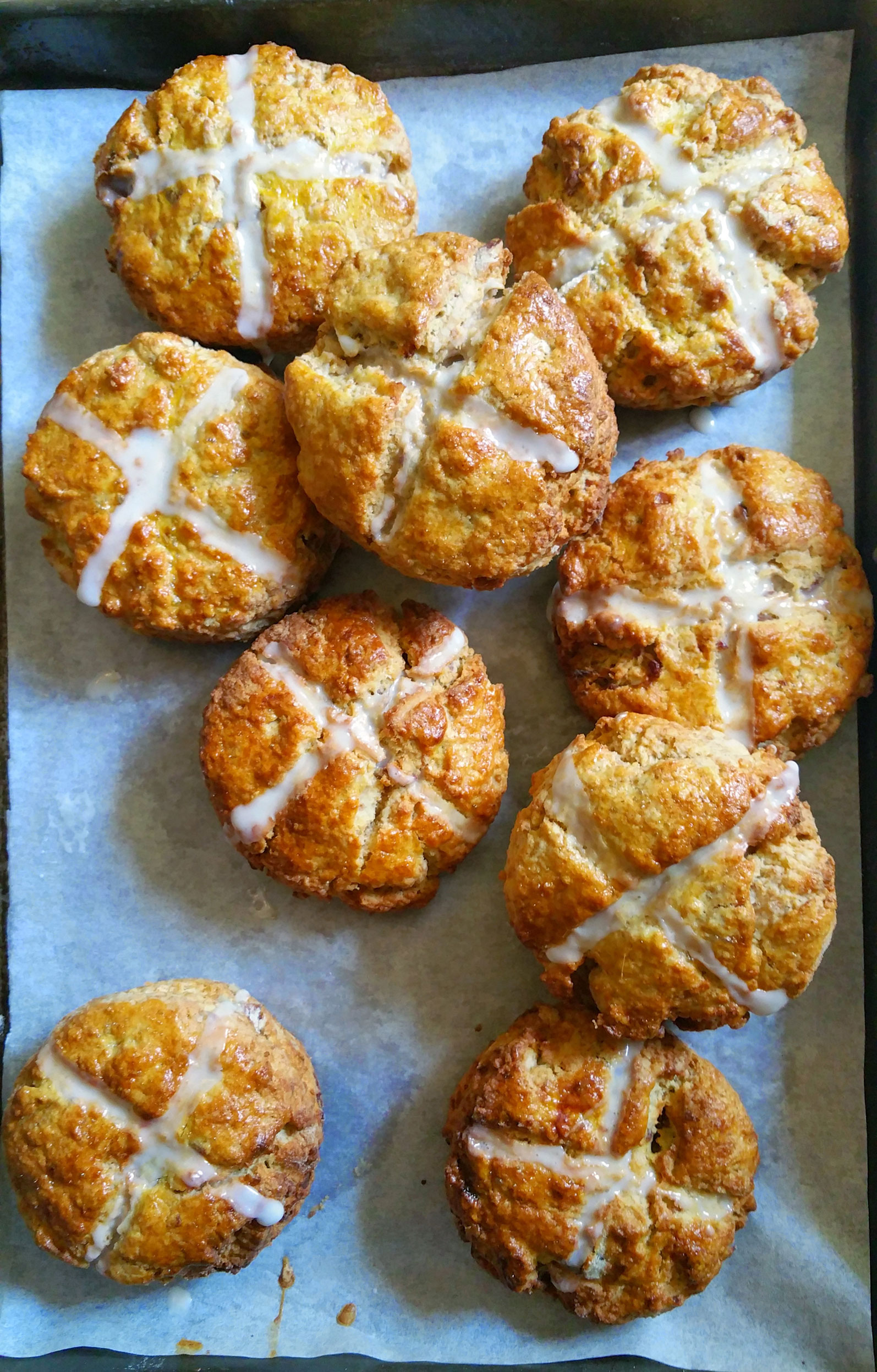
Hot Cross Scones {with rum soaked dates and toasted pecans}
On April 3, 2015 by sixtyacrebakerCome Easter, I yearn for all the delicious delights from both my childhood, and my travels. Whilst (see how I did that?) living in London, the hot cross bun craze eluded me. I participated, but was never that enthusiastic about the taste. They however, are fun to make, and do signal the last days of the Lenten season…which is joy in and of itself. In the tradition of Good Friday must eats (if you are not fasting today), I give you Hot Cross Scones. Instead of raisins, they have rum soaked dates and toasted pecans. You’re welcome.
These, like hot cross buns, are meant to be shared “Half for you and half for me, between us two goodwill shall be” While the “diddy” intimates sharing a single bun, this recipe makes about a dozen scones. I don’t think anyone would balk at the notion that 6 a piece is fair share.
Hot Cross Scones {with dates and pecans}
for the scones
1/2 cup dried dates: chopped into raisin size pieces
1/2 cup spiced rum
1 cup whole wheat flour
1 cup all purpose flour
4 Tsp baking powder
1/2 cup granulated sugar
1/2 tsp ground ginger
1/4 tsp ground cinnamon
3/4 tsp kosher salt
6 Tbs unsalted butter–cold and cut into small pieces
1/2 cup toasted pecans–chopped
3/4 cup heavy cream–cold
1 large egg
1 tsp vanilla
for the icing
1/3 cup powdered sugar
pinch ground ginger
1 tsp +/- heavy cream
to make scones
Heat the spiced rum over low heat, and pour over the chopped dates. Let sit for no less than 10 minutes and up to an hour. Drain well. In a large bowl whisk together the whole wheat and all purpose flour, baking powder, granulated sugar, ginger, cinnamon and salt. Using a pastry cutter, or your hands cut the butter into the flour mixture. Do not overwork. Toss the drained dates and pecans in. Give them a quick stir to coat with flour. Whisk the cream, egg and vanilla together and add all at once to the flour mixture. Using your hands gently mix together. When the dough has just come together, place onto a lightly floured surface and shape, by hand or with a roller, into a 3/4″ round. sprinkle a bit of flour on top, if sticky, and cut out with 3″ round cutter. Place on lined sheet pan. Using the back of a knife, swept in flour, make a cross indentation in the top. Brush with egg wash or the remains of your egg/cream mixture. Bake at 400F for about 15 minutes. Ice when cooled.
to make the icing
Place powdered sugar in a small bowl, whisk in ground ginger. Add cream 1 tsp at a time until the mixture is thin enough to pipe, but not too thin. You don’t want a runny icing. Pipe with a pastry bag.
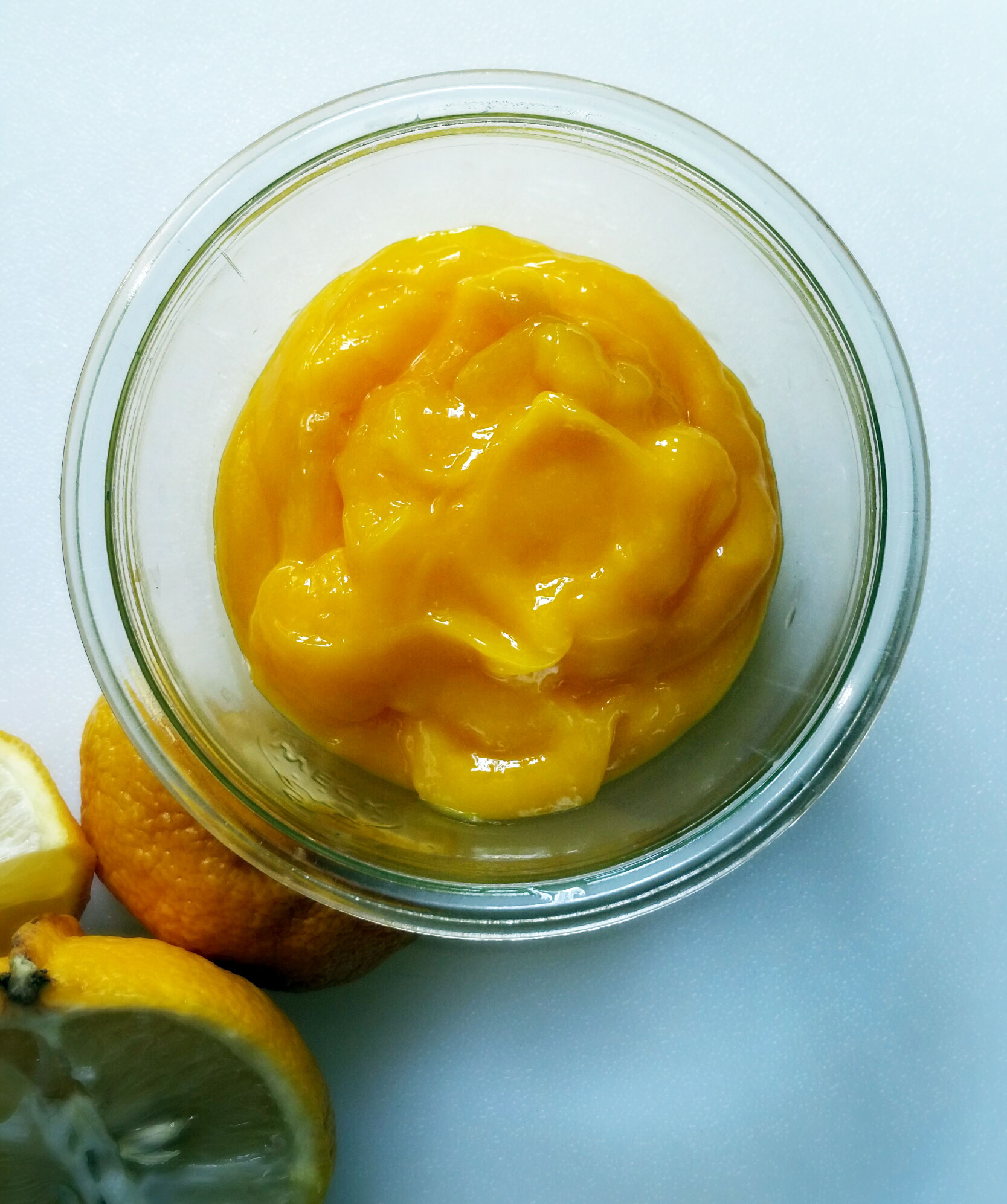
Lemon Curd
On March 30, 2015 by sixtyacrebakerI have been waxing lyrical about lemon curd for days. Finally, the desire had become so overwhelming, I took matters into my own hand. It was time. My counter top had become over-run with duck eggs, a basket of lemons was prepping for it siren song to the fruit fly migration, and I can only stand the thoughts in my head for so long. The hue of this curd is overwhelmingly beautiful and true. It is a foreshadow to the bright treat I love so much.
Lemon Curd
makes approx 3 1/2 cups
8 extra large egg yolks
1 cup granulated sugar
3/4-1 cup fresh lemon juice*
1 Tbs lemon zest
pinch kosher salt
1/2 cup unsalted butter-cut into pieces
Place the butter in a glass or ceramic bowl and set aside. Place egg yolks, sugar, lemon juice, lemon zest and salt in a med/large saucepan or high sided saute pan. Whisk to fully incorporate all ingredients. Place over low heat and stir continually with a spatula. Be mindful to scrape the sides and bottom of pan while stirring. Continue stirring until the mixture thickens enough to heavily coat the spatula, and you can easily trace a clear path through with your finger. Do not let the mixture simmer or boil, otherwise you will cook your egg yolks. Remove from heat and pour through a sieve directly into the bowl with the butter. Whisk until all of the butter is melted and incorporated into the curd. The sieve will catch any cooked particles and most of the zest. This will allow for a clear texture to your curd.
To cool, place the bowl of curd into a larger bowl of ice water (mostly ice) and stir until the temperature reduces to room temp. You may continue cooling to use immediately, or place a piece of plastic wrap directly onto the curd and allow to finish cooling in the refrigerator.
*I enjoy a very tart lemon curd as I mostly pair with sweet meringue, shortbread, or ice cream. If you like it a bit more tame, use 3/4 cup of lemon juice, if you are like me, use 1 cup.
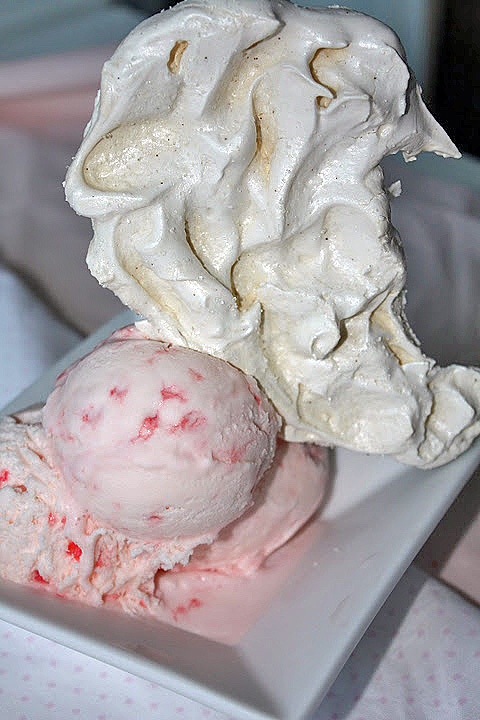
Cupid’s Wings
On February 10, 2015 by sixtyacrebakerI find egg whites whipped, billowy and cloud-like, to be utterly satisfying. They are a testament to the notion that desserts don’t have to be fussy to be extraordinary. Their only real requirement is a clean bowl and strong wrist. On the ranch, eggs are readily available for a last minute fix. This valentine’s day, I will use the yolks for a decadent frozen custard, and the whites for these ethereal wings.
Meringue
3 large egg whites at room temperature
1/4 tsp cream of tartar
3/4 cup sugar
1/2 tsp vanilla
pinch of salt
Make sure the beater and bowl are extremely clean and free of any oil or fats. Beat whites on low until foamy. Add salt and then kick up the speed to medium. Add cream of tartar. Begin to slowly add the sugar “raining” it into the egg whites. Continue to beat until soft peaks form, then add vanilla. Beat to stiff and firm peaks.
If you over-beat, you will see moisture starting to “weep” from the whites. If this happens, start over!
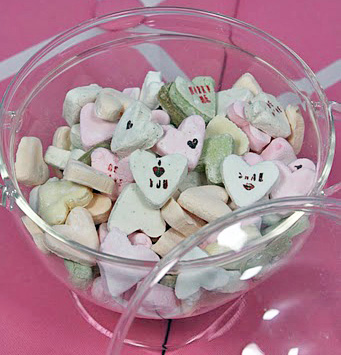
Homemade Conversation Hearts
On February 5, 2015 by sixtyacrebakerValentine’s day wouldn’t be complete without a conversation through candy hearts. I remember the days when hearts were carefully shared, making sure “i love you” didn’t get inadvertently passed, to a 4th grade crush. Also important: sharing only
the good flavors. Anyone would shudder to see the object of her affection, chewing up and spitting out her heart. Ten years old is too young to fully understand foreshadowing. I am confident any valentine would appreciate an “i love you” or three in flavors such as orancello, coconut, green tea, almond, anisette, coffee and vanilla bean. These are so much fun to make. I think a robin’s egg blue box full of “marry me” hearts would be a darling proposal. Or a love poem stamped out word by word, heart by heart, snaked down the dining room table, as a simple but thoughtful centerpiece. The possibilities are endless.
Just. Like. Love

Conversation Hearts
1/4 oz gelatin
1/2 cup water
2 tsp light corn syrup
2 lbs powdered sugar
cornstarch
flavorings
color
rubber stamp kit and/or food color pens
Place water in a bowl and sprinkle gelatin over. Let bloom. Add the corn syrup and gently cook in the microwave until the gelatin and corn syrup have melted. Do this in 20 second intervals. Mix the gelatin mixture into about 2/3rds of the powdered sugar. Knead with your hands, adding more powdered sugar as necessary until the dough is satiny and doesn’t stick to the counter. Divide the dough into 6-8 pieces, coloring and flavoring as desired. Keep tightly wrapped in plastic wrap, as this dough will dry out quickly. Keep some powdered sugar on hand, in case adding color and flavor makes the dough sticky.
Roll the dough out and cut with small heart cutter. Place on a cornstarch dusted sheet pan and let dry a minimum of 48 hours. When ready to decorate, use food color based pens, or brush food coloring directly onto a rubber stamp with the words spelled backwards. Press the heart onto the stamp and let dry about 15 minutes. You can also paint food coloring directly onto the heart as well.
{this is a post transcribed from my blog fudgeripple. the content exclusively belongs to me}
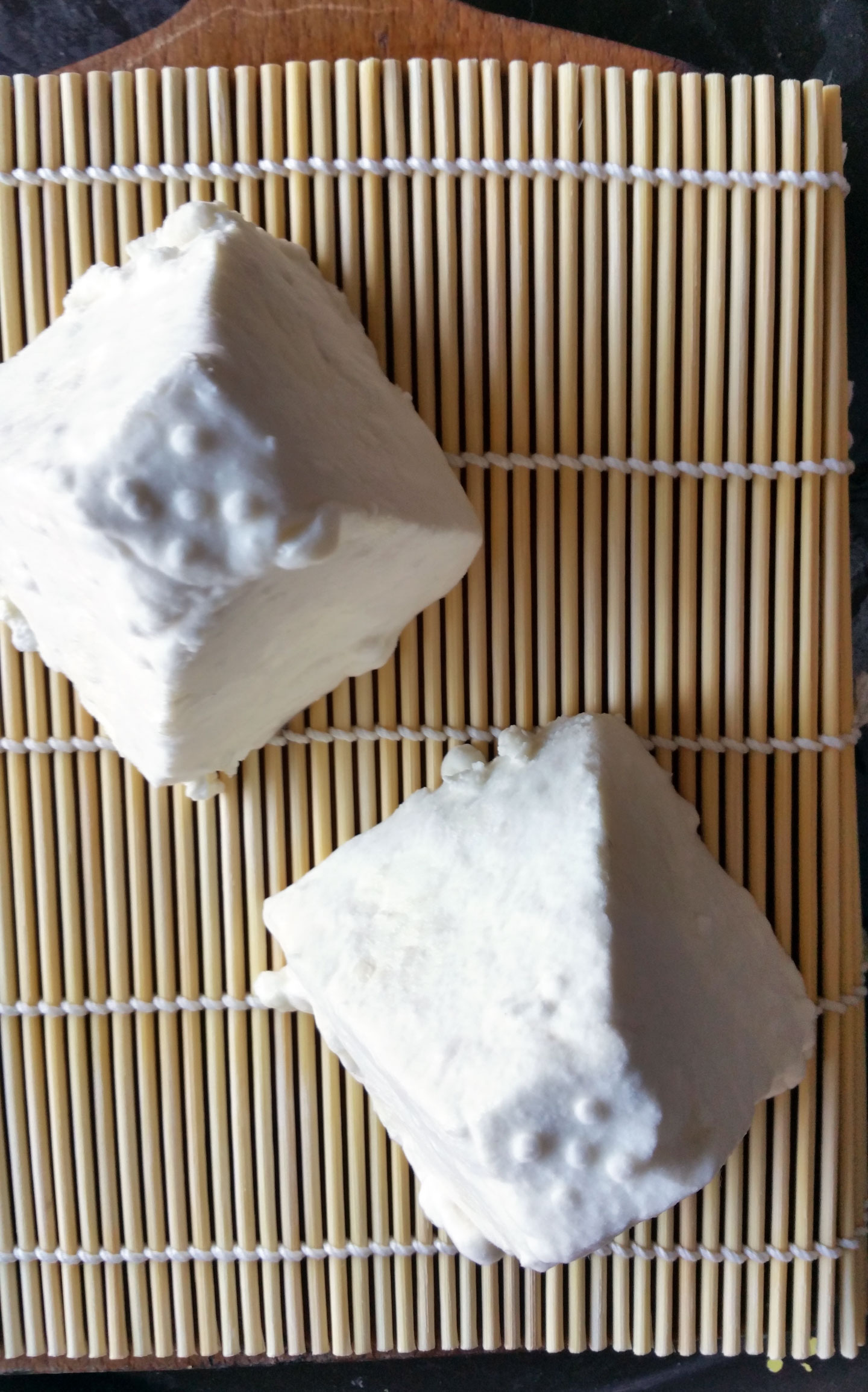
My Cheesy Manifesto
On January 15, 2015 by sixtyacrebakerThere is a huge difference between following a recipe and understanding why the recipe follows the path it does. Cheese making is a blend of science and art. I have been making cheese for quite sometime. I have success, and I have failure. The problem was that I didn’t really understand why; if following the same process time and time again, the results would prove different. The variables in cheese making are complex. There are ways to nurture the natural bacteria in milk and ways to try and beat them at their own game. But until I understood the difference between; morning milk and afternoon milk, winter milk and spring milk, high fat milk breeds and low fat milk breeds, raw and pasteurized milk, acceptable coliform and scary coliform, my experiments in cheese making would continue to be hit or miss. I took a short-course this past week that help me discern the difference. I came away with an understanding of the need to be flexible, while adhering to strict protocol. Sound confusing? Well that is because it kinda sorta is.
I’m going to be painfully honest. I don’t really even like cheese that much. As I write this, I am averting my eyes from the gaze of those words. I am ashamed. Let me clarify. I don’t hate cheese, I like it in small amounts and when it has good flavor. I’m into a good sharp cheddar, or truffled chevre, even a nice chunk of parmesan lights my world. However, I’m that girl that, when ordering french onion soup, asks them to go light (or not at all) on the gooey cheese top. I’m also the one that sneers at the over-cheesed pizza and grated cheese on a side salad. Rather humorous that I’m working so hard to get our goat herd up to level, so I can milk them to make cheese, no?
No.
I want to make good cheese. Cheese that makes its impression in small amounts. Cheese that you don’t have to eat an entire wheel of to realize you just ate cheese. Cheese from beautiful animals raised on quality grass and feed, with a nice life. I’d say happy. But I’m not sure how to measure happy in a ruminant. They aren’t miserable…that I know.
To make good cheese, so much has to happen even before the milk hits the creamery. Cheese making is the truth in “farm to fork” manufacturing. The most valuable thing I have learned, and it sounds really hippy dippy, is to let the milk tell me what kind of cheese to make. Yes, I can force and manipulate to get a facsimile of a type of cheese I like. That is the science. However, right now my plan is, to let the milk tell me what kind of cheese it should be. I’m going to sit with that for a while, as I make my plans for our little dairy business.
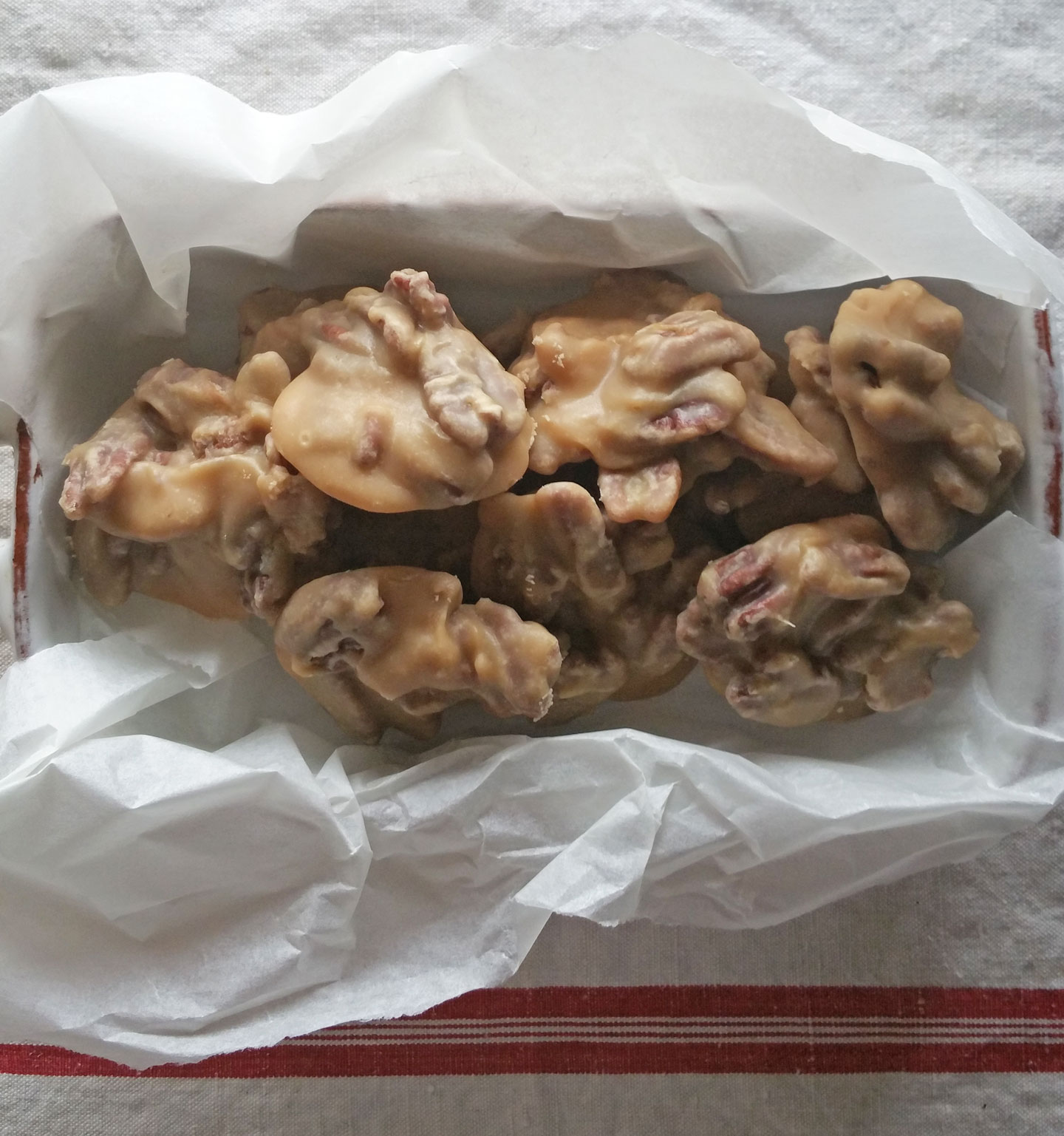
Pecan Pralines
On December 15, 2014 by sixtyacrebakerPRAWWWWWWlines. Say it with me, and then get in the kitchen and make some. You won’t be disappointed. I Guarantee It.
This recipe came from my love of the sweet confection. I have been obsessed with the treat since my first visit to New Orleans way back when Emeril had a last name. I printed this recipe and a story to go with it on my previous blog, but they are so good, I thought they warranted their own page on Sixty Acre Baker. They make a perfect holiday (or any time of year, really) gift.
Pecan Pralines
1 quart heavy cream
3 cups granulated sugar
generous pinch of kosher salt
1 1/2 lbs toasted pecans
1 Tbs+ 1 tsp lemon juice
1 Tbs unsalted butter
2 tsp vanilla
In a heavy bottomed pan, stir together the cream, sugar and salt. Place on low to med-low heat and pop in a candy thermometer. Cook until thermometer reaches 234 degrees F. The wait between 220 and 234 is lengthy..don’t be tempted to up the heat to make it happen faster. You can pretty much leave it alone until it reaches 220, at 220, stay in the kitchen checking on it frequently. When it hits 230, watch it and start stirring, it will start to change colors at this point and you want to make sure the bottom doesn’t burn. There will be brown bits, but just mix them in. Stir, stir, stir. When it hits 234, take the pot off the heat, remove the thermometer and add the lemon juice, vanilla, butter and pecans. Stir to incorporate, then pop the thermometer back in and bring the temp back to 234. It will go a bit faster this time, keep an eye on it and stir continually to prevent burning on the bottom. When it hits 234, spoon it out in dollops (i use a soup spoon),onto parchment lined cookie sheets, or aluminum foil that has been sprayed or greased lightly.There are a lot of pecans in this, so make sure you get a nice mix of the caramelly goodness. One batch will make about 50 moderately sized pralines. They will look like caramel until you cool them. As they cool and sit, they will begin to get a bit cloudy. That is a good thing. You are not looking for chewy here.
Let cool for a few hours. They will keep for quite a while if you keep them in an airtight container in a dry place. Please, do not put in the fridge.

After the Rain
On December 13, 2014 by sixtyacrebakerWe’ve been having a bit of weather here lately. We are in the Central Coast of California and have been in serious drought conditions. The recent rains are welcome, but challenging as well. We’ve had a lot of dirt, and now we have a lot of mud. Keeping the house clean is the least of my worries, but the biggest of my annoyances. We’ve outfitted a large canvas tent for our overnight guests. With the temps dropping, we recently installed a wood-stove to keep the tent warm and cozy. Last night, along with the rain, we had some pretty rough winds. They were so strong, they blew the cap off the wood-stove pipe and the tent fly. As a result the woodstove filled with water, and we had some moisture in the tent. All was easily remedied by draining out the water and starting a good hot fire. I may have taken a wee little afternoon nap; arising just in time for this beautiful scene.
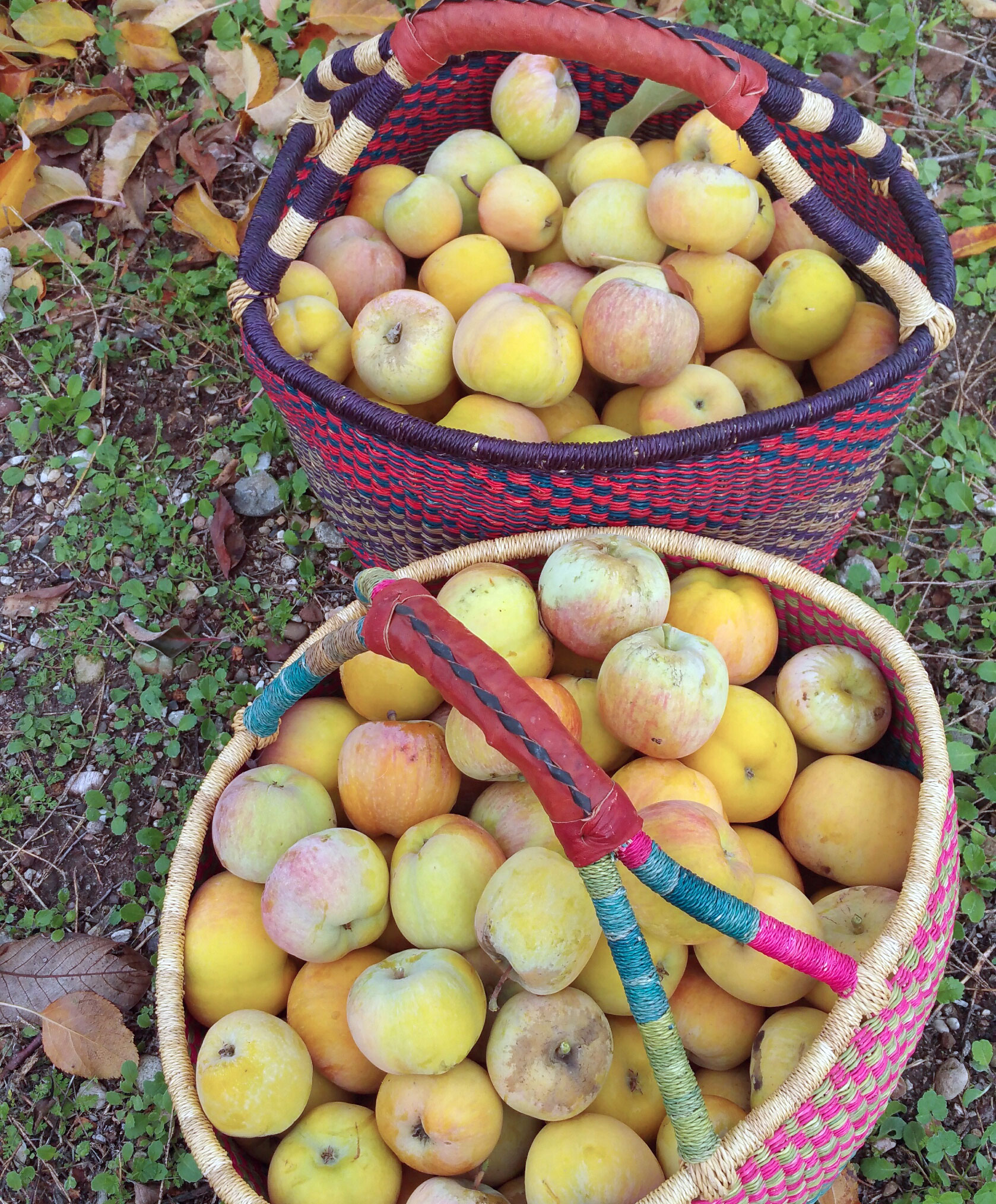
Apple Fritters
On December 7, 2014 by sixtyacrebakerMike planted 20 plus varieties of apples in our orchard. We have pie apples, sauce apples, snack apples, brandy apples and cider apples. To further the cause, our neighbor also grows a variety in her orchard. We are not starved for apples from late spring to early winter. Today, in the dense of early morning mist and chill, I picked the trees clean. Bushels and bushels of apples. A workout and a treat! These apples are slated for hard cider. I’m still gathering all of the supplies, but I will be pressing the apples this week, and starting the fermentation process straight away. I’ll keep you posted on the progress. With any luck it won’t end up like the root beer project of 2005. Spoiler alert, it ended with me in a delightfully rich, if not sticky, bath.
While you (and I) are waiting for the results of the cider…you may want to try making these delicious apple fritters.

Apple Fritters
for the apples
1 cup apples–cut in a 1/4″ dice
1 Tbs sugar
1 Tbs lemon juice
pinch cardamom
pinch nutmeg
pinch cinnamon
mix together in a bowl and let sit while you do your preparations
for the batter
1 cup apple cider
2 cups flour
1/2 cup sugar
1 tsp kosher salt
1 Tbs baking powder
1/2 tsp cinnamon
1/2 tsp nutmeg
1/3 cup milk
1 tsp vanilla
3 Tbs unsalted butter–melted
2 large eggs
oil for frying
Simmer the apple cider on the stove until it is reduced to 1/4 cup, and let cool. Heat your oil in a sturdy deep pot, to 360F. Your oil should be deep enough so the fritter can float, but you must also have at least 3″ between the top of the pot and the top of the oil. Meanwhile, place all your dry ingredients in a bowl and whisk to combine. Make a well in the center and pour in milk, vanilla, butter, cider and eggs. Slowly stir together, making sure all ingredients are incorporated, but do not beat. Stir in the apple and any juices that may have accumulated. you can make these small or big, the process is the same. Drop into hot oil and then using a spatula poke it a few times to flatten it a bit and give it some nooks and crannies. Fry until golden brown, then flip and continue until both sides are equally colored. Remove from oil and place on a cooling rack, placed over a sheet pan.
for the glaze
1 cup powdered sugar
2 Tbs (more or less) cider
Mix together in a shallow bowl. When the fritters are still warm, but not too hot to touch, dip in the glaze.
